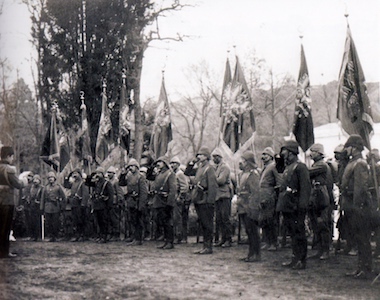
Having been defeated by Russia in the war of 1877-78, it became evident that the army was in dire need for reform and the Ottoman government began to take the necessary steps. The reform process commenced with a fundamental revision wherein the German military system replaced the French one, which had so far influenced the army. From 1882 onwards, German officers began to be deployed in the army, and the first German military mission arrived in Istanbul the same year, led by a cavalry officer named Koehler. This mission's task was to train the Turkish officers and to make recommendations.
Sultan Abdülhamit II promoted Koehler to the rank of general and appointed him as his aide-de-camp. However, having to spend most of its time at the Imperial Palace, this German mission failed to produce fruitful results. Koehler passed away in 1883 and was replaced by Lt.Col. Colmar von der Goltz, who was also promoted to the rank of general and became the Inspector of Military Schools. Later on he was made the Deputy Chief of General Staff, but he had to work within a severely limited competence due to the Sultan’s suspicions about him. Goltz still managed to undertake a number of changes in the army, which proved to be helpful in the war against the Greeks in 1897, one year after Goltz returned to Germany.
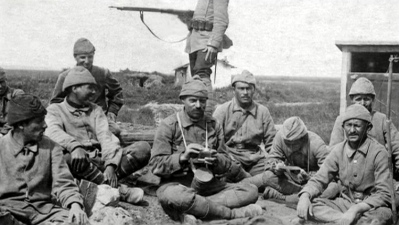
Several statesmen, especially the Grand Vizier Sait Pasha, were aware of the fact that a radical change was needed in the army, but they could not persuade Sultan Abdülhamit. There was not only a serious shortage of funds to provide the army with adequate equipment, but the training system was also in ruins. The War Academy could train only small numbers of qualified officers; therefore, in order to fill the gap, there had emerged a new class of officers called “alaylı”, who were simply promoted to these ranks without going through the military schools.
Promotions were made arbitrary, there were no clear rules. Those close to the palace could get promotions faster and their rise led to worsening moral decay in the army. For those who did not have the connections, it was often the case that they stayed at the same rank for several years (sometimes 10-15 years) no matter how qualified they were. Salaries were low and they were paid only once every 5-6 months, which led to corruption.
Unjust promotions had created any “army of generals”. During Abdülhamit’s reign there were 31 field marshals and 468 generals in the Ottoman Army. Unqualified officers were not able to train their men. Soldiers were only doing the daily routine drills and the reserves were not taken care of at all. Even in the War Academy, the education was very poor. The weapons they had were old and low in numbers. Sultan Abdülhamit bought modern weapons from Germany, but they were not distributed to the army, instead they were kept locked in depots. The navy was obsolete and lying anchored in the Golden Horn.
The statesmen and the commanders in the army had no political and military goals in common. Neither was there coordination among the armed forces. Units belonging to the same division did not communicate with each other and it was mostly the case that when a regiment was in one part of the Empire another regiment was stationed hundreds of kilometres away. Coordinated action among the units of the same group was simply not a part of the military tradition.
After the proclamation of the constitutional rule in 1908, the Ottoman General Staff began to work to correct these deficiencies. The weapons kept locked in depots were distributed to armies and the new “Regulation on Military Organization” was adopted with a decree on July 9, 1910. Major revisions brought about by the new regulations were as follows:
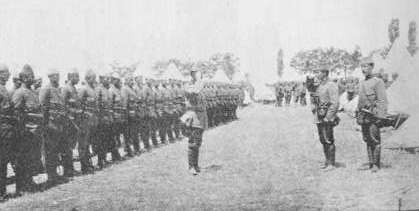
a. Army commands were replaced by “army inspectorates” of which the main responsibility was training and mobilization.
b. The army was to be composed of three parts: regular army (nizamiye), reserve army (redif) and the home guard (müstahfız).
c. A new army unit, the “corps”, was established. They were to be composed of three divisions and other ancillary units.
d. An infantry division was to be composed of three infantry regiments, a sharpshooter battalion, a field artillery regiment and an army band.
e. Each corps in the regular army was to consist of 41 thousand men and 6,700 animals.
f. Reserve divisions were to be combined into reserve corps and they were to be given artillery units.
g. Units of the regular army would recruit soldiers through the sources of the army inspectorate they belonged to.
h. All male citizens of the Empire were subject to compulsory military service. Previously, non-Muslims and the citizens of Istanbul were exempted.
i. The regular army was made of the 1st, 2nd, 3rd and 4th Army Inspectorates and their ancillary corps, as well as the freestanding 14th Yemen Corps, 41st Asir Division, 42nd Tripoli Division and 43rd Hejaz Division that were directly reporting to the Ministry of War.
j. The reserve army (redif) had five inspectorates, which contained 57 divisions as well as a regiment in Çanakkale.
The regular army was divided into two classes. Those actually under arms for four years were called muvazzaf and those who had completed this four year service and then incorporated for one or two years in the ihtiyat (active reserve) to serve in their region of origin, where they acted as a kind of permanent backbone to the local redif batalion.
Those who had completed their service with the regular army, those who had been allowed to return to their homes on grounds of being the sole breadwinners of the family and those who were over 32 years of age served with the redif for a further six years, as did those whose name had not come up to begin with. The müstahfız reserve was the least active, least well-armed part of the army. It was not expected to take the field in times of war, but rather to take over garrison duties and general law-and-order work, when the regular army and the reserve were at the front.
Goltz Pasha Returns
Another important development in this period was the return of Goltz Pasha. In 1909, the Minister of War Ali Rıza Pasha had asked the Ottoman military attaché in Berlin, Major Enver Bey, to persuade Colmar von der Goltz to serve the Ottoman Army once again after 13 years. Goltz said to Enver that there are only two years left until his retirement and during this time he could come to Turkey for periods of four months, after the German autumn maneuvers. The Ministry of War accepted Goltz’s proposal and he came to Turkey on a salary of 250 golden liras.
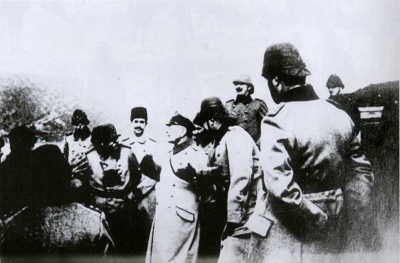
Goltz Pasha’s contribution to the Ottoman Army was important, although it did not fully produce the desired results. He established standards for the training of different branches. Fourteen German officers of ranks between captain and lieutenant colonel came to Turkey, and they took posts in the Ottoman Army at one rank higher. It was also decided to send young and promising Turkish officers to Europe for training. However all these attempts brought only limited benefits to the army. The German contribution could not go further than the theoretical level. Officers sent to Paris, Berlin, Vienna, Rome, London and Petersburg could not add substantial value to the Ottoman Army upon their return because the military doctrines of armies they were sent to were completely different.
During this period, an important priority of the Ottoman Army was to reform the officer cadres. A majority of the officers in the army were the ones called “alaylı”; those who were promoted to those ranks without going through military schools. There had emerged conflicts between them and the mektepli officers; graduates of the War Academy and to make this separation worse, there were the “born officers”. Princes and other important statesmen were considered as army officers and were given ranks as soon as they were born.
Rejuvenation of the army was also necessary. Among the “alaylı” officers there were lieutenants who were 58 years old, captains who were 65 years old and majors who were 80 years old. The “mektepli” officers were relatively younger, but they were also old compared to European armies: majors 59, captains 42 and lieutenants 31 years of age.
A decree issued in 1909 brought age limits to officer cadres. According to this decree, the age limits were 41 for lieutenant, 46 for captains, 52 for majors, 55 for lieutenant colonels, 58 for colonels, 60 for brigadier generals, 65 for generals and 68 for field marshals. As a result, as of January 1911, a total of 10,189 officers (nearly three fourths being “alaylı”) had retired.
This liquidation was well intended, but the problem was that there were not enough officers in the army. There were big gaps in the cadres and it was impossible to fill them with military school graduates in a short period of time.
The German Military Mission
These were the conditions as the Ottoman Army entered the Balkan Wars. The defeat in the Balkans caused the Ottoman General Staff and the Ministry of War to consider a second wave of reforms in the army and this time the idea as to actively engage the expertise of German officers. Diplomatic contacts with Germany to that end began even before the end of the Balkan Wars and the idea materialized during the time of Grand Vizier Sait Halim Pasha and Minister of War Ahmet İzzet Pasha in office. Kaiser Wilhelm II accepted the proposition to send a German Military Mission to Turkey.
At that time, there was a British Naval Mission led by Admiral Limpus and a French Gendarmerie Mission led by General Moujen in Turkey. The government did not hesitate to add to this list a German mission and a five-year contract with Germany was signed on October 27, 1913. The mission was to be led by General Otto Liman von Sanders, commander of the 22nd Prussian Division stationed in Kassel.
General von Sanders was to be appointed as the commander of the I Corps in Istanbul and become a member of the War Council, where his opinion would matter but the final decision was to be made through a majority vote. Turkish leaders had realized that the mistake with Goltz’s mission was that his authority was kept limited. This time they equipped von Sanders with a wide range of powers.
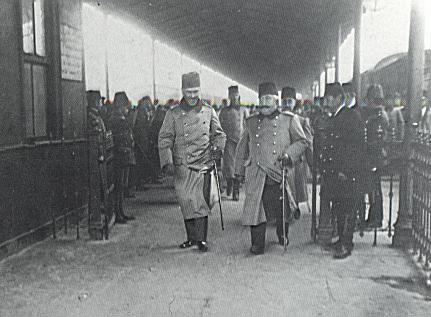
General von Sanders and his staff of ten officers arrived in Istanbul on December 14, 1913, bringing the total number of German officers in the Ottoman Army to 41. All of them were given ranks in the Ottoman Army, which were one rank higher than what they were back in Germany. In addition to von Sanders’ appointment as the commander of I Corps, General Bronsart von Schellendorf became the commander of the 3rd Division and also the First Deputy Chief-of- Staff of the Ottoman Army, Col. Zadernstorn the commander of 5th Division, Col. Tronnier the commander of the 10th Division, Lt.Col. Nicolai the commander of the 3rd Artillery Regiment, Cpt. Stange the commander of 8th Infantry Regiment. Lt.Col. von Strumbel became the chief of staff of the German Military Mission and Lt.Col. Feldmann became the head of the 3rd Department of the Turkish General Staff. The remaining officers were given to different headquarters and military schools.
Within a short period time, the German Military Mission had remarkable achievements with structural reforms and providing a more efficient military training system. Meanwhile, German officers continued to come to Turkey, with their number rising to 70 by mid-1914. General von Sanders was in a position that made him the third man in the Ottoman Army after the Sultan himself and the Minister of War. He had access to all sorts of classified information and he was the one controlling the promotions of officers. His monthly salary was 275 golden liras plus allowances and benefits.
The Germans’ arrival in Turkey worried the Allied nations. Britain and France joined the protests of Russia, which criticized the appointment of a German general as a corps commander in the Ottoman Army. At that time there was no formal military alliance between Turkey and Germany and the government was considering all alternatives for a European alliance including those with Britain, France and Russia. The 9th article of the contract of the German Military Mission had clearly stated that in case of a war the contract would be annulled. The Allied protests were mainly aiming at slowing down the development of Turkish military; where as the Turkish approach was rather pragmatic. The General Staff wanted to get the expertise from whoever could provide the best.
In 1913, the reserve army and the home guard were abolished and a major restructuring was carried out in the Ministry of War, where young officers played a substantial role.
Enter Enver Pasha
In late 1913, the Committee of Union and Progress was exerting a great pressure on the military to have Lt.Col. Enver Bey, the “Hero of Liberty”, appointed the Minister of War. The government did not have the power to resist, but the problem was that Enver’s rank was too low. A formula was found, which gave Enver special promotions for his participation in the Turco-Italian War and the Balkan Wars and in less than three weeks, the lieutenant colonel became a general.
The first thing done by the young Minister of War was to eliminate the remaining old officers in the army. Especially those who failed in the Balkan Wars were forced to retire and they were replaced with young ones. Enver Pasha believed that the only way for the Ottoman Army to thrive was to make the best use of dynamic and sophisticated young officers and also to benefit from the German Military Mission. Enver Pasha also abolished the War Council and assumed all the responsibility of the new reform process he launched himself.
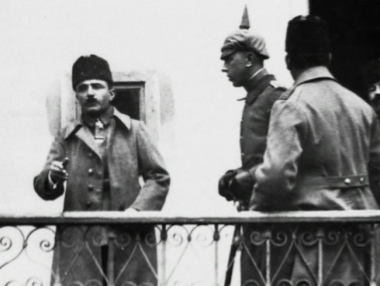
Enver Pasha’s idea was to establish a war-time army during peace time, instead of facing the necessity to create new divisions during mobilization. To that end, each army was to have corps of three divisions each and each division was to have three infantry regiments, one artillery regiment and ancillary units. Infantry regiments had three battalions with four companies each and a machine gun detachment. Artillery regiments had two battalions with four guns each. In mobilization, the infantry regiments would receive a fourth battalion and the artillery regiments would get a third battalion.
It was a good idea but Enver needed 450 thousand more men to fill in the cadres. These gaps could only be filled by war-time conscription, since it was impossible to achieve such big numbers in peace time. The army was still weak because it could only be equipped whatever weapons and vehicles Turkey had. The financial situation of the dying empire could not feed the war machine.
Enver Pasha valued strict discipline in the army. Although he was deeply involved in politics, he made sure that politics stayed away from the ranks and file. He intensified the training activities so much that the members of the armed forces would have no time for getting involved in anything else. He encouraged taking initiatives and he adhered to principles of rewards and punishment.
At that time it was though that the army was its maximum size and it was not possible to expand it further from its size in 1914. However, when Turkey entered the World War, Enver Pasha’s desires and the increasing influence of the Germans resulted in changes in the army. As the number of fronts where Turkish troops fought increased, so did the number of army units, but although all the resources of the country were fully mobilized, it was still not possible to provide enough manpower for this increasing number of army units. Although at some point there were nine armies and 61 divisions, none of those armies had the strength of a peace-time corps. New divisions were established during the course of the war but in 1918 as the war neared its end, the number of divisions went down to its pre-war level, which was 38.